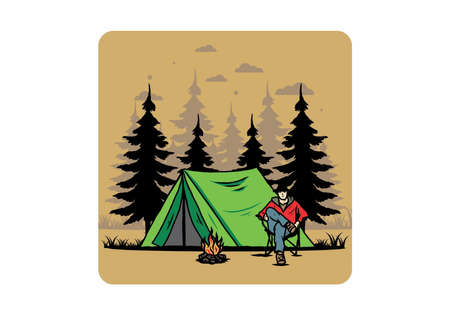Embracing the Rainy Forecast: Mindset and Flexibility
When you see rain in the forecast for your car camping trip, its easy to feel disappointed or even frustrated. But a rainy weekend doesn’t have to ruin your adventure—in fact, it can make for some of the most memorable stories and experiences. The key is preparing yourself mentally before you even hit the road. First, recognize that weather is part of the outdoor experience and accept that things might not go exactly as planned. Instead of dreading the wet weather, try reframing your mindset: rain brings out unique sights, sounds, and smells in nature, and it can turn an ordinary trip into something special.
Flexibility is also crucial. While you might have had visions of sunny hikes or campfire evenings, adapting your plans to suit the conditions will help keep everyone happy. Consider packing extra games, books, or a deck of cards for cozy time inside your car or tent. Think about alternative activities like scenic drives, wildlife watching from the comfort of your vehicle, or exploring local attractions nearby.
Above all, keep a positive attitude and remember why you’re camping in the first place—to unplug, connect with nature, and enjoy time with friends or family. A little rain just adds to the adventure. With an open mind and willingness to adapt, camping in wet weather can be surprisingly rewarding.
Gear Essentials: Staying Dry and Comfortable
When the forecast calls for rain, packing the right gear can make or break your car camping experience. Keeping yourself, your gear, and your sleeping setup dry is a mix of smart clothing choices, waterproof equipment, and some practical hacks. Here’s what you need to know:
Recommended Waterproof Gear
| Item | Why It Matters | Pro Tips |
|---|---|---|
| Waterproof Tent with Rainfly | Keeps your sleeping area dry even in heavy rain. | Choose a tent with a full-coverage rainfly and seam-sealed construction. Set up on higher ground to avoid puddles. |
| Tarp or Footprint | Provides an extra layer between the ground and your tent. | Place under your tent, but tuck edges underneath to prevent water from pooling. |
| Waterproof Duffel Bags/Dry Sacks | Protects clothes, electronics, and food from getting soaked. | Organize items by use (sleeping, cooking, clothing) for quick access in bad weather. |
| Rain Shelter/Canopy | Gives you a dry space outside your vehicle for cooking or relaxing. | A pop-up canopy or large tarp strung between trees works well for communal spaces. |
| Camping Chairs with Drainage Holes | Avoid sitting in puddles during downpours. | Look for mesh-bottom chairs designed for wet conditions. |
Clothing Tips for Wet Weather Camping
- Layer Up: Start with moisture-wicking base layers (think synthetic or merino wool) to keep sweat off your skin. Add insulating mid-layers and finish with a breathable waterproof jacket and pants.
- Avoid Cotton: Cotton soaks up water and dries slowly, leaving you cold and clammy. Stick to technical fabrics whenever possible.
- Ponchos vs. Rain Jackets: Ponchos are great for quick coverage, especially when moving between the car and camp. For all-day comfort, invest in a quality rain jacket with adjustable cuffs and hood.
- Dry Feet = Happy Camper: Waterproof boots or shoes paired with wool socks will help keep your feet warm and dry. Pack extra socks in zip-top bags—changing into dry socks at night feels amazing!
- Packing Hack: Use compression sacks to store spare clothes; they’ll take up less room and stay protected from leaks.
Car Camping Hacks to Stay Dry
- Create a Dry Entryway: Use an awning or umbrella at your car’s door so you can change out of wet clothes before getting inside. Lay down an old towel or mat to catch drips and mud.
- Shoe Management: Bring plastic bins or bags for muddy shoes—don’t let them live in your sleeping area! Leave slippers or flip-flops handy for walking around inside the car or under cover.
- Damp Gear Solutions: Hang a paracord clothesline under your canopy or between open car doors to air out damp jackets or towels. Avoid drying things inside the car overnight to prevent condensation build-up.
- Bedding Protection: Lay a waterproof blanket or picnic mat on top of your mattress setup to block any accidental leaks. Use sleeping bags rated for damp conditions if rain is likely all night long.
- Clever Storage: Store electronics, matches, and snacks in sealable containers or zip-lock bags—nothing ruins morale like soggy granola bars!
Your Car as a Rain Shelter: Quick Checklist
| Shelter Option | Best Use Case |
|---|---|
| Sitting inside with windows cracked open (use rain guards/visors) | Waiting out a storm without getting stuffy inside the vehicle. |
| Laying seats flat & setting up sleeping pad/bag in back | Avoiding wet tents when it’s pouring outside; always ventilate slightly to reduce condensation. |
The key is preparation—bring waterproof layers, protect your gear before it gets wet, and use both your car’s interior and external shelters creatively. With these essentials dialed in, rainy weather won’t dampen your adventure spirit!

3. Setting Up Your Campsite for Wet Weather
When the forecast calls for rain, setting up your campsite becomes both a science and an art. Making smart choices from the start will help keep you dry and comfortable throughout your car camping adventure.
Choosing the Right Campsite
First things first: location matters. Avoid pitching your tent at the bottom of hills or in natural depressions where water can pool. Instead, look for higher ground with a gentle slope to encourage runoff. Steer clear of areas directly under large trees—not only can dripping branches make it feel like it’s raining long after the storm has passed, but falling limbs during a storm are a real risk.
Setting Up Tarps and Shelter
A tarp is your best friend in wet weather. String a large tarp above your cooking and communal areas using sturdy paracord tied to trees or secured with poles. Angle one side lower than the other to let water run off efficiently—think of it as a makeshift roof. If possible, set up another tarp beneath your tent area to act as a footprint, but make sure it doesn’t extend beyond the tent edges or you’ll accidentally collect more water underneath.
Tent Placement and Preparation
Lay down a waterproof groundsheet inside your tent as extra insurance against moisture seeping in. Double-check that all zippers are closed and rain flies are securely fastened. Stake out your tent tightly so that water runs off rather than pooling on top. If your tent is older, treat the seams with seam sealer before your trip to prevent leaks.
Keeping Water Out of Your Living Space
Avoid tracking mud and water inside by setting up a designated “mudroom” just outside your tent door—a small mat or towel works well. Store shoes, wet jackets, and gear outside or in your car if possible. Be diligent about zipping up entrances quickly, and use quick-dry towels to mop up any sneaky drips.
With these strategies in place, you’ll have a fighting chance against even persistent rain showers—and you might even come to appreciate how cozy car camping can be when you’re properly prepared for wet weather.
4. Cooking and Eating in the Rain
Rain can put a serious damper on your plans for grilling hot dogs or making s’mores over an open fire. But don’t let wet weather stop you from enjoying good food during your car camping trip. With some creativity and a little preparation, you can still eat well—even if you have to stay under cover. Here are some practical ideas for prepping meals and dining when the sky won’t clear up.
Car-Based Meal Prep: Your Mobile Kitchen
Your vehicle is more than just shelter; it can double as a makeshift kitchen when the rain is relentless. Many American campers keep portable stoves or camp kitchens that work perfectly under an open hatchback or a large awning. If your car has enough space, consider using the trunk area (with proper ventilation) or lay down a tarp and cook just outside the door, shielded by umbrellas or tarps.
Meal Ideas When You Can’t Grill
| Meal Type | Rain-Friendly Options |
|---|---|
| Breakfast | Instant oatmeal, bagels with cream cheese, breakfast burritos (pre-made at home), hard-boiled eggs |
| Lunch | Deli sandwiches, wraps, pasta salad, canned soups (heated on camp stove) |
| Dinner | Canned chili, one-pot pasta dishes, pre-cooked rice bowls with beans/veggies, foil packet meals (prepared ahead) |
| Snacks | Granola bars, trail mix, fruit cups, jerky |
Keeping It Dry and Comfortable
If you’re eating inside your car or under a tarp, bring along extra towels and napkins to keep things tidy. Collapsible camping tables can fit easily beside your vehicle and provide a dry spot for meal prep. Don’t forget leak-proof containers—no one wants soggy bread or waterlogged chips! For drinks, insulated thermoses keep coffee or hot chocolate warm while you watch the rain fall.
Pro Tip: Make Meals Ahead of Time
If you know there’s rain in the forecast, prep as much as possible at home. Chop veggies, marinate proteins, or assemble salads in sealed containers. This way, you’ll spend less time exposed to the elements and more time enjoying a hot meal in comfort.
5. Making the Most of Rainy Days: Fun Activities and Cozy Moments
Just because it’s raining doesn’t mean your camping trip has to be a washout. In fact, some of the best memories come from those unexpected cozy moments spent together while the rain taps on your car roof. With a little creativity and a few simple comforts, you can turn a soggy day into an adventure everyone will remember.
Classic Games for Rainy Day Fun
Pack a deck of cards, travel-sized board games, or even dice for classic fun that never gets old. Games like Uno, Go Fish, or Yahtzee are easy to play in the car or under an awning. If you’re feeling more creative, try charades or a round of “20 Questions”—no extra supplies needed.
Curl Up with a Good Book
Rainy weather is perfect for diving into that book you’ve been meaning to read. For families or groups, bring along a couple of storybooks and take turns reading aloud by lantern light. Audiobooks are another great option—download a few before your trip and listen together as the rain patters outside.
Simple Comforts: Warm Drinks and Snacks
Nothing beats a mug of hot cocoa or instant coffee when it’s chilly and damp. Pack an insulated thermos or use your camping stove to heat water safely under cover. Pair warm drinks with easy comfort snacks like popcorn, trail mix, or s’mores made over a portable camp stove. These little treats bring warmth and cheer to any dreary day.
Create Your Own Cozy Space
Layer up with blankets and soft pillows inside your car or tent to create a snug hideaway. String up battery-powered fairy lights for ambiance, play soft music, or just listen to the rainfall together. This downtime is a chance to slow down and reconnect—whether through conversation, journaling, or simply enjoying the peaceful atmosphere.
Make Memories That Last
Rainy days might not have been part of your original camping plan, but embracing them can lead to spontaneous fun and meaningful moments. With games, good books, warm snacks, and plenty of laughter, you’ll find that camping in the rain can be just as rewarding—and maybe even more memorable—than a sunny day outdoors.
6. Safety and Clean-Up in Wet Conditions
Rainy weather brings an extra layer of challenge to car camping, especially when it comes to staying safe and cleaning up efficiently. Here are some key safety tips and best practices to keep in mind when breaking camp in the rain.
Watch Your Step: Slippery Surfaces
Mud, wet leaves, and slick rocks can turn a campsite into a slip-and-slide. Always wear sturdy, waterproof boots with good traction, and move carefully—especially near slopes or riverbanks. Lay down old towels or tarps at your tent entrance to reduce muddy footprints inside your vehicle or tent.
Wet Gear Maintenance
Keeping your gear dry is not just about comfort; its about avoiding mold and prolonging the life of your equipment. If possible, pack wet items separately using heavy-duty trash bags or dry sacks. Once you get home, immediately unpack and air-dry everything—even if it seems only slightly damp. A little extra effort now will save you from unpleasant surprises later.
Handling Electronics and Food
Keep electronics in waterproof containers or double-bagged ziplocks. For food storage, use airtight bins to prevent water intrusion and critter access. Remember, any perishables that got wet should be tossed to avoid foodborne illness.
Breaking Camp Efficiently
When it’s time to pack up, do as much as you can from inside your vehicle or under a tarp shelter to stay dry. Fold tents and tarps loosely if theyre wet—tight packing encourages mildew. Double-check the area for forgotten gear, trash, or tent stakes before you leave; leave no trace is even more important in soggy conditions where debris can get buried fast.
With a little extra care for safety and clean-up, you can finish your rainy camping trip on a high note—and look forward to the next adventure with all your gear ready to go.


